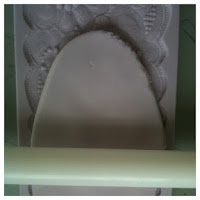As a little girl, my favourite sweets were panama violets, were? who am I kidding! - are, I cannot pretend that the bumper mixed bag of sweets that I purchased recently was for any other reason than that it contained some packets of these sparkling with nostalgia morsels. Regrettably it appears that my son is also rather fond of them and Mummy's packet is usually blessed with additional sticky fingers
So, you can imagine it was with some delight when calling in to my local sugar craft shop for some cake board or fondant or some other sundry, long since forgotten, that I noticed they had started stocking flavourings that included the rarely discovered violet. I usually like to use a natural flavouring or at least provide a natural alternative, however, I think that this is one of those occasions when you need to buy a flavouring, unless you happen to have an abundance of violets and the knowledge of how to infuse their flavour.
Ingredients
This sponge part of this cupcake is a standard equal measure creamed sponge, with a teaspoon or so of the violet flavouring added and, if you like, a couple of toothpick dunks of violet colouring. For 12 small cupcakes you will need a two egg recipe. Weigh your two eggs, which will probably weigh about 100 grams or 4 oz and then weigh out equal amounts of butter or margarine, caster sugar and self raising flour.
Method
Cream together the butter or margarine and sugar with the violet flavouring until light and fluffy. Add the eggs one at a time, adding a tablespoon of your flour if the mixture struts to curdle and beat well. Finally add the flour, mixing until just mixed in. Over mixing you flour can make the texture of the cake hard, so stop when just mixed. Divide the mixture between your baking cases and bake at 350 F / 180 C for about 15 minutes. The cakes are cooked when they spring back, if you press them lightly on top.
Frosting
This is a sweet chocolaty buttercream frosting. Make sure that you sift the icing sugar and cocoa powder if you are going to pipe the frosting otherwise you can guarantee that those pesky little lumps are going to get stuck in your piping nozzle or tip.
 Ingredients
Ingredients300g icing / confectioners sugar sifted
100g unsalted butter (soft)
40g cocoa powder sifted
40 ml whole milk or cream
Method
Mix together the sifted icing / confectioners sugar and sifted cocoa powder. Beat the butter until soft. Add about a third of the icing sugar cocoa powder mix and beat really well. Add the milk and beat again until combined. Add another third of the icing / confectioners sugar and coca mix and beat again and finally beat in the rest of the sugar and cocoa mix
The frosting is piped onto the cakes using a Wilton 2 D nozzle / tip, piping from the inside towards the edge. To finish the cupcake I have sprinkles on crystallised violet flowers from Squires Kitchen.
What would i do differently next time?
These cupcake are super scrummy, if i was going to make them again, I would add a little more colouring to my sponge mix, I didn't get the shade of violet that I wanted. When you add violet colour to a yellow cake mix, it turns quite a grey colour initially, this tends to put you off adding any more, whereas actually this is the stage you need to add more colour. I would also like the frosting to be a darker chocolaty shade and should perhaps have used a chocolates fudge icing.
That's all for today
Thanks for popping by and please call again soon
Keep up with my latest creations and inspirations in all these places




